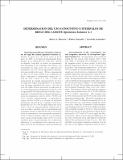Mostrar el registro sencillo del ítem
Determinación del uso consuntivo e intervalos de riego del camote (Ipomoea batatas L.)
Ascertainment of the consumptive use and irrigation intervals of sweetpotato (Ipomoea batatas L.)
| dc.creator | Moreira, Marco A. | |
| dc.creator | González, Walter | |
| dc.creator | Granados, Gerardo | |
| dc.date.accessioned | 2019-08-08T21:07:46Z | |
| dc.date.available | 2019-08-08T21:07:46Z | |
| dc.date.issued | 1994 | |
| dc.identifier.issn | 1011-8659 | |
| dc.identifier.uri | https://hdl.handle.net/10669/78771 | |
| dc.description.abstract | Durante la época seca, del 16 de enero al 12 de mayo de 1986, en la Estación Experimental Fabio Baudrit, de la Universidad de Costa Rica, ubicada en Alajuela, Costa Rica, se realizó un experimento para determinar el uso consuntivo del camote y sus necesidades de riego. Para ésto se aplicaron tres tratamientos: 25, 50 y 75% de agotamiento de humedad aprovechable del suelo. El área experimental se ubicó en un suelo Andept y las condiciones de lluvia, temperatura y luminosidad variaron de 0 a 0,81 cm, 22,8 a 24,10 ºC y 7,81 a 11,45%, respectivamente. La unidad experimental fue de 50 m de largo para lograr homogeneidad en la distribución del riego superficial por surcos. En todo el ciclo del cultivo fueron necesarios la aplicación de 17, 10 y 8 riegos para los tratamientos de 25, 50 y 75% de agotamiento de la humedad aprovechable, respectivamente. La humedad antes y después del riego en todos los tratamientos varió de 40,04 a 55,08% y de 57,07 a 64,25%, respectivamente. A capacidad de campo, ésta fue 61,38% y en el punto de marchitez permanente, 38,10%. El uso consuntivo total de los tratamientos 25, 50 y 75% de agota-miento fue 51,84; 45,40 y 39,40 cm, respectivamente, durante todo el ciclo de cultivo; mientras que la evapotranspiración acumulada durante el experimento fue 97,32 cm para todos los tratamientos, con un promedio mensual de 19,44 cm. Esta se mantuvo entre 20 y 22 cm durante enero y marzo; luego tendió a bajar a 18,74 y 14,72 cm en abril y mayo, res-pectivamente. No se detectaron diferencias el ren-dimiento total comercial, pero sí hubo efecto de los tratamientos sobre la producción de raíces clase A. El agotamiento del 50% de humedad aprovechable fue el mejor tratamiento, debido a que presentó el mayor rendimiento comercial de raíces clase A y el menor costo de riego. Los tratamientos presentaron diferencias significativas en el peso del follaje a cosecha. Se manifestó un mayor crecimiento de la plantas cuando se mantuvo el suelo con un agota-miento del 25% de humedad aprovechable. | es_ES |
| dc.description.abstract | An experiment was conducted during the dry season, from January 16th to May 12th, 1986, to determine the consumptive use and the irrigation needs of sweet potato, at the Fabio Baudrit Experiment Station of the University of Costa Rica. The treatments applied were: 25, 50 and 75% of available soil moisture depletion. The experimental area was located on a Andept soil, where the rainfall, temperature and luminosity varied from 0 to 0.81 cm, 22.8 to 24.1ºC and 7.81 to 11.45%, respectively. An experimental unit of 50 m long was used to achieve distribution homogeneity of the surface irrigation. It was necessary to apply 17, 10 and 8 irrigations for the 25, 50 and 75% available soil moisture depletion treatments during the entire crop cycle, respectively. The moisture, before and after the irrigation, varied in all treatments from 40.4 to 55.08% and from 57.07 to 64.25%, respectively. The moisture was 61.38% at field capacity and 38.10% at the onset of the permanent wiltness stage. The total consumptive use of the 25, 50 and 75% depletion treatments was 51.84, 45.40 and 39.40 cm, respectively, during the whole crop cycle, while the accumulated evapo-transpiration during the trial was 97.32 cm for all the treatments, with a monthly average of 19.44 cm. This was stable between 20 and 22 cm from January to March, then it decreased to 18.74 and 14.72 cm in April and May, respectively. There were no detected differences on the total commercial yield, although the treatments affected the production of class A roots. The 50% available soil moisture depletion treatment was the best due to the highest commercial yield of class A roots and it lowest irrigation cost. The treatments showed significant differences of foliage weight at harvest time. A larger plant growth was manifested when the soil was kept with 25% available moisture depletion. | en_US |
| dc.format | application/pdf | |
| dc.language.iso | es | es_ES |
| dc.publisher | Universidad de Costa Rica | es-ES |
| dc.rights | Todos los derechos reservados 1994 | * |
| dc.source | Boletín Técnico, Vol 27(2), pp. 1-10 | es_ES |
| dc.subject | Lpomoea batatas | es_ES |
| dc.subject | riego de superficie | es_ES |
| dc.subject | uso del agua | es_ES |
| dc.subject | balance hídrico | es_ES |
| dc.subject | Costa Rica | es_ES |
| dc.subject | Ipomoea batatas | es_US |
| dc.subject | surface irrigation | es_US |
| dc.subject | water use | es_US |
| dc.subject | water balance | es_US |
| dc.subject | Costa Rica | es_US |
| dc.title | Determinación del uso consuntivo e intervalos de riego del camote (Ipomoea batatas L.) | es_ES |
| dc.title | Ascertainment of the consumptive use and irrigation intervals of sweetpotato (Ipomoea batatas L.) | en_US |
| dc.type | artículo original | |
| dc.description.procedence | UCR::Vicerrectoría de Investigación::Unidades de Investigación::Ciencias Agroalimentarias::Estación Experimental Agrícola Fabio Baudrit Moreno (EEAFBM) | es_ES |
Ficheros en el ítem
Este ítem aparece en la(s) siguiente(s) colección(ones)
-
Vol. 27 [15]


